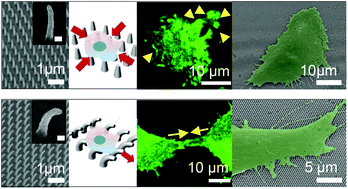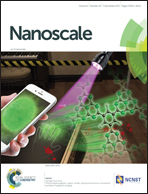Cellular behavior controlled by bio-inspired and geometry-tunable nanohairs†
Abstract
A cicada wing has a biocidal feature of rupturing the membrane of cells, while the cactus spine can transmit a water drop to the stem of the plant. Both of these properties have evolved from their respective unique structures. Here, we endeavor to develop geometry-controllable nanohairs that mimic the cicada‘s wing-like vertical hairs and the cactus spine-like stooped hairs, and to quantitatively characterize the cell migration behavior of the hairy structures. It was found that the neuroblastoma cells are highly sensitive to the variation of surfaces: flat, vertical, and stooped nanohairs (100 nm diameter and 900 nm height). The cells on the vertical hairs showed significantly decreased proliferation. It was found that the behavior of cells cultured on stooped nanohairs is strongly influenced by the direction of the stooped pattern of hairs when we quantitatively measured the migration of cells on flat, vertical, and stooped structures. However, the cells on the flat structures showed random movement and the cells on the vertical nanohairs restricted the nanohair movement. Cells on the stooped structure showed higher forward migration preference compared to that of the other structures. Furthermore, we found that these cellular behaviors on the different patterns of nanohairs were affected by intracellular actin flament change. Consistent with these results, the vertical and stooped structures can facilitate the control of cell viability and guide directional migration for biomedical applications such as organogenesis.



 Please wait while we load your content...
Please wait while we load your content...